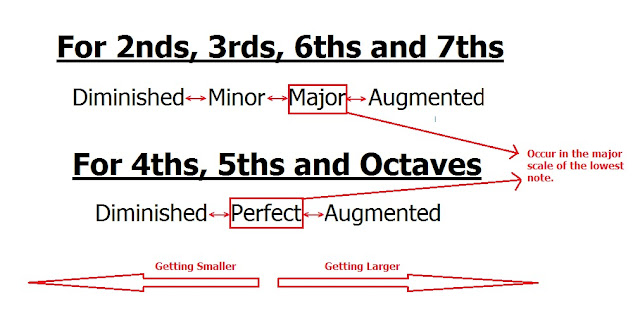In Lesson 3.7 you learned the prefixes major, minor and perfect as applied to intervals. To summarize; 4ths, 5ths and Octaves are perfect. 2nds, 3rds, 6ths and 7ths are major if they occur in the major scale of the lower note.
Minor intervals are a semitone less than major intervals.
In this lesson there are two more prefixes as applied to intervals
so C# to A is a semitone less i.e. a minor 6th
and C# to Ab would be a diminished 6th
Minor intervals are a semitone less than major intervals.
In this lesson there are two more prefixes as applied to intervals
Augmented and Diminished
Perfect and major intervals can be augmented
(increased by a semitone)
Perfect and minor intervals can be diminished
Perfect and minor intervals can be diminished
(decreased by a semitone).
Let's consider some examples
F to A sharp is an augmented 3rd (increased by a semitone)
F to A flat is a minor 3rd (decreased by a semitone)
F to A double flat is a diminished 3rd (a minor 3rd decreased by yet another semitone).
F to B flat is a perfect 4th (B flat is the 4th note of F major and remember there is no such thing as a major or minor 4th)
F to B natural is an augmented 4th. (Increased by a semitone).
F to B double flat is a diminished 4th (Decreased by a semitone).
Many people find this quite complicated but if you follow this flow chart you can't go wrong.
For 2nds, 3rds, 6ths & 7ths
- If the upper note is in the major scale of the lower note it is MAJOR
- If it is a semitone less it is MINOR
- If it is a semitone more it is AUGMENTED
- If it is 2 semitones less it is DIMINSHED
For 4ths, 5ths and Octaves.
- If the upper note is in the major scale of the lower note it is PERFECT.
- If it is a semitone less it is DIMINISHED
- If it is a semitone more it is AUGMENTED.
The only problem may arise if the lower note is one you do not know the major scale of, Csharp to A flat for example.
If you asked the interval between C sharp and A flat first consider the major scale of a note you do know i.e. C major.
Now C - A is a major 6th
so C# to A is a semitone less i.e. a minor 6th
and C# to Ab would be a diminished 6th
Practice this topic with our workbook
"Music Theory Practice - A Complete Course"
New for 2021












No comments:
Post a Comment
Comments with external links not accepted and WILL BE DELETED